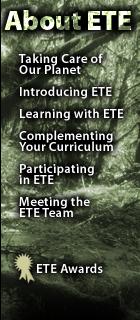 
|
Using Computers Doing Problem-based
Learning in Collaborative Learning Groups Analyzing Remote
Sensing Imagery The remotely-sensed satellite images used in ETE modules are images of the earth taken from NASA satellites or aircraft, which students download from the Internet. The images, however, are not taken by ordinary cameras, and they may vary from traditional photographs in many ways, especially in color and scale. Interpreting them may involve physical manipulation (cropping, rotating) or mathematical manipulation (processing) of the digital data stored in the pixel array of the image. These manipulations are done in the classroom by students using image processing software. Students access these software products by following instructions in the ETE modules. |
|
|
Taking
Care of Our Planet ..|..
Introducing ETE ..|..
Learning with ETE ..|..
Complementing Your Curriculum ..|..
Participating in ETE ..|..
Meeting the ETE Team ..|..
ETE Awards
|
|
Discuss Exploring the Environment! Some images © 2004 www.clipart.com. Privacy Statement and Copyright © 1997-2011 by Wheeling Jesuit University/NASA-sponsored Classroom of the Future. All rights reserved. Center for Educational Technologies, Circuit Board/Apple graphic logo, and COTF Classroom of the Future logo are registered trademarks of Wheeling Jesuit University.
|